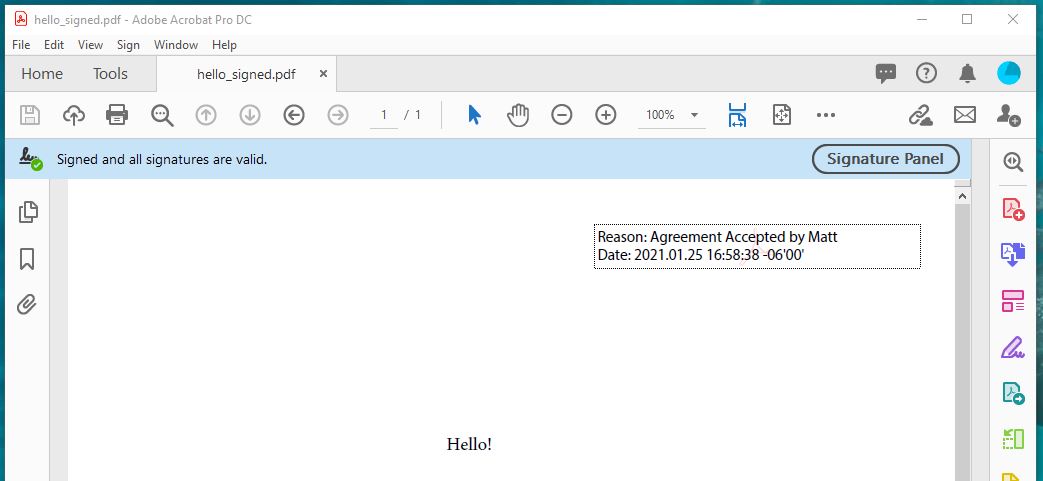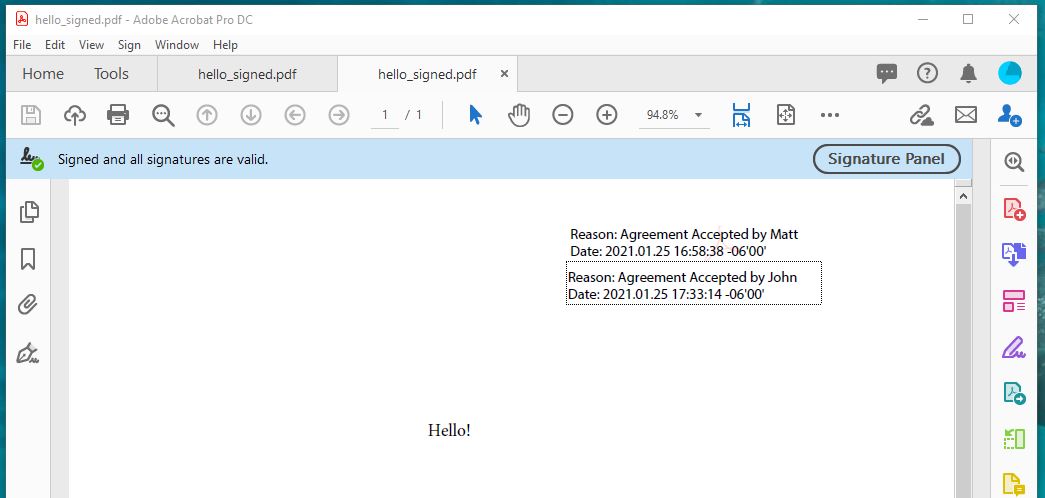|
|
(Objective-C) PDF Sign Under Existing Signature
This example explains how sign a previously-signed PDF and place the signature appearance below the existing signature.
Note: This example requires Chilkat v9.5.0.85 or greater.
#import <CkoPdf.h>
#import <CkoJsonObject.h>
#import <CkoCert.h>
// This example requires the Chilkat API to have been previously unlocked.
// See Global Unlock Sample for sample code.
CkoPdf *pdf = [[CkoPdf alloc] init];
// Load a PDF to be signed.
BOOL success = [pdf LoadFile: @"qa_data/pdf/sign_testing_4/hello_signed.pdf"];
if (success == NO) {
NSLog(@"%@",pdf.LastErrorText);
return;
}
// The PDF we'll be signing already has a signature added in Adobe Acrobat DC.
// It looks like this:
// (Notice the Adobe background logo, which is commonly what you'll see when a signature
// is created by Adobe Acrobat. Chilkat (obviously) does not create signatures using the Adobe
// logo because it would be a copyright violation.)
 // Options for signing are specified in JSON.
CkoJsonObject *json = [[CkoJsonObject alloc] init];
// In most cases, the signingCertificateV2 and signingTime attributes are required.
[json UpdateInt: @"signingCertificateV2" value: [NSNumber numberWithInt: 1]];
[json UpdateInt: @"signingTime" value: [NSNumber numberWithInt: 1]];
// To put our new signature underneath the existing signature, we have to specify the page
// where the existing signature is found, and then we can specify "under" for the "appearance.y"
[json UpdateInt: @"page" value: [NSNumber numberWithInt: 1]];
[json UpdateString: @"appearance.y" value: @"under"];
[json UpdateString: @"appearance.fontScale" value: @"10.0"];
[json UpdateString: @"appearance.text[0]" value: @"Reason: Agreement Accepted by John"];
[json UpdateString: @"appearance.text[1]" value: @"Date: current_dt"];
// Load the signing certificate. (Use your own certificate.)
CkoCert *cert = [[CkoCert alloc] init];
success = [cert LoadPfxFile: @"qa_data/pfx/myPdfSigningCert.pfx" password: @"secret"];
if (success == NO) {
NSLog(@"%@",cert.LastErrorText);
return;
}
// Tell the pdf object to use the certificate for signing.
success = [pdf SetSigningCert: cert];
if (success == NO) {
NSLog(@"%@",pdf.LastErrorText);
return;
}
// Note: When adding an additional signature to a PDF, the existing signatures
// are validated, and this includes validating the certificates previously used to
// create the existing signatures. (A signature typically embeds the signing certs.)
// In some cases, the certificates and/or certs in the chain of authentication for
// existing signatures are not present, and are not available on the current system.
// In this case, you can skip the validation by setting this keyword in UncommonOptions:
pdf.UncommonOptions = @"NO_VERIFY_CERT_SIGNATURES";
success = [pdf SignPdf: json outFilePath: @"qa_output/hello_signed.pdf"];
if (success == NO) {
NSLog(@"%@",pdf.LastErrorText);
return;
}
NSLog(@"%@",@"The PDF has been successfully cryptographically signed.");
// Here's a screenshot of the 2nd signature positioned under the 1st in Adobe Acrobat:
// Options for signing are specified in JSON.
CkoJsonObject *json = [[CkoJsonObject alloc] init];
// In most cases, the signingCertificateV2 and signingTime attributes are required.
[json UpdateInt: @"signingCertificateV2" value: [NSNumber numberWithInt: 1]];
[json UpdateInt: @"signingTime" value: [NSNumber numberWithInt: 1]];
// To put our new signature underneath the existing signature, we have to specify the page
// where the existing signature is found, and then we can specify "under" for the "appearance.y"
[json UpdateInt: @"page" value: [NSNumber numberWithInt: 1]];
[json UpdateString: @"appearance.y" value: @"under"];
[json UpdateString: @"appearance.fontScale" value: @"10.0"];
[json UpdateString: @"appearance.text[0]" value: @"Reason: Agreement Accepted by John"];
[json UpdateString: @"appearance.text[1]" value: @"Date: current_dt"];
// Load the signing certificate. (Use your own certificate.)
CkoCert *cert = [[CkoCert alloc] init];
success = [cert LoadPfxFile: @"qa_data/pfx/myPdfSigningCert.pfx" password: @"secret"];
if (success == NO) {
NSLog(@"%@",cert.LastErrorText);
return;
}
// Tell the pdf object to use the certificate for signing.
success = [pdf SetSigningCert: cert];
if (success == NO) {
NSLog(@"%@",pdf.LastErrorText);
return;
}
// Note: When adding an additional signature to a PDF, the existing signatures
// are validated, and this includes validating the certificates previously used to
// create the existing signatures. (A signature typically embeds the signing certs.)
// In some cases, the certificates and/or certs in the chain of authentication for
// existing signatures are not present, and are not available on the current system.
// In this case, you can skip the validation by setting this keyword in UncommonOptions:
pdf.UncommonOptions = @"NO_VERIFY_CERT_SIGNATURES";
success = [pdf SignPdf: json outFilePath: @"qa_output/hello_signed.pdf"];
if (success == NO) {
NSLog(@"%@",pdf.LastErrorText);
return;
}
NSLog(@"%@",@"The PDF has been successfully cryptographically signed.");
// Here's a screenshot of the 2nd signature positioned under the 1st in Adobe Acrobat:

|

